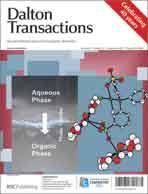Reactions of the preformed cluster [(η5-C5Me5)2Mo2(μ3-S)4Cu2(MeCN)2](ClO4)2 (1) with two tetraphosphine ligands, 1,4-N,N,N′,N′-tetra(diphenylphosphanylmethyl)benzene diamine (dpppda) and N,N,N′,N′-tetra(diphenylphosphanylmethyl)ethylene diamine (dppeda), produced two bicyclic clusters {[(η5-C5Me5)2Mo2(μ3-S)4Cu2]2(L)}(ClO4)4 (3: L = dpppda; 4: L = dppeda). Analogous reactions of 1 or [(η5-C5Me5)2Mo2(μ3-S)4Cu2(MeCN)2](PF6)2 (2) with two N,P mixed ligands, N,N-bi(diphenylphosphanylmethyl)-2-aminopyridine (bdppmapy) and N-diphenylphosphanylmethyl-4-aminopyridine (dppmapy), afforded two monocyclic clusters {[(η5-C5Me5)2Mo2(μ3-S)4Cu2]2(L)2}X4 (5: L = bdppmapy, X = ClO4; 6: L = dppmapy, X = PF6). Compounds 3–6 were fully characterized by elemental analysis, IR spectra, UV-vis spectra, 1H and 31P{1H} NMR spectra, ESI-MS and single-crystal X-ray crystallography. In the tetracations of 3–6, two cubane-like [Mo2(μ3-S)4Cu2] cores are linked either by one dpppda or dppeda bridge to form a bicyclic structure or by a pair of bdppmapy or dppmapy bridges to afford a monocyclic structure. The third-order nonlinear optical (NLO) properties of 1 and 3–6 in MeCN were also investigated by femtosecond degenerate four-wave mixing (DFWM) technique with a 50 fs pulse width at 800 nm. Compounds 3–6 exhibited enhanced third-order NLO performances relative to that of 1.
![Graphical abstract: Assembly of bicyclic or monocyclic clusters from [(η5-C5Me5)2Mo2(μ3-S)4(CuMeCN)2]2+ with tetraphosphine or N,P mixed ligands: syntheses, structures and enhanced third-order NLO performances](/en/Image/Get?imageInfo.ImageType=GA&imageInfo.ImageIdentifier.ManuscriptID=C1DT10685F&imageInfo.ImageIdentifier.Year=2011)

 Please wait while we load your content...
Please wait while we load your content...